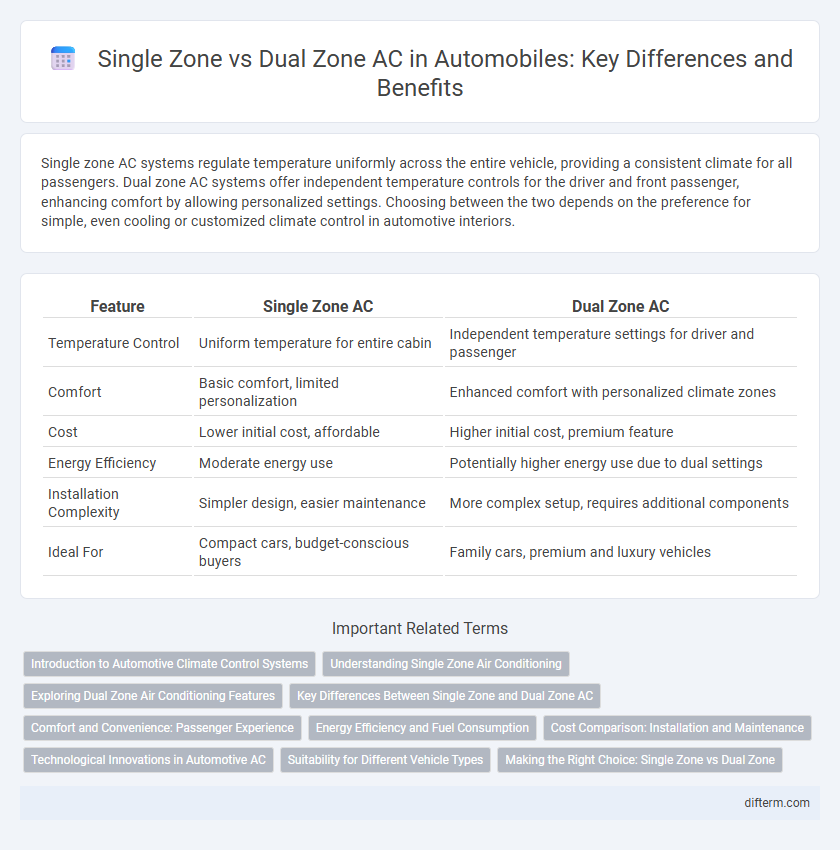Single zone AC systems regulate temperature uniformly across the entire vehicle, providing a consistent climate for all passengers. Dual zone AC systems offer independent temperature controls for the driver and front passenger, enhancing comfort by allowing personalized settings. Choosing between the two depends on the preference for simple, even cooling or customized climate control in automotive interiors.
Table of Comparison
| Feature | Single Zone AC | Dual Zone AC |
|---|---|---|
| Temperature Control | Uniform temperature for entire cabin | Independent temperature settings for driver and passenger |
| Comfort | Basic comfort, limited personalization | Enhanced comfort with personalized climate zones |
| Cost | Lower initial cost, affordable | Higher initial cost, premium feature |
| Energy Efficiency | Moderate energy use | Potentially higher energy use due to dual settings |
| Installation Complexity | Simpler design, easier maintenance | More complex setup, requires additional components |
| Ideal For | Compact cars, budget-conscious buyers | Family cars, premium and luxury vehicles |
Introduction to Automotive Climate Control Systems
Automotive climate control systems regulate cabin temperature and humidity to ensure passenger comfort and safety. Single zone AC systems provide uniform temperature control throughout the vehicle interior, while dual zone AC systems enable independent temperature settings for the driver and front passenger. Advancements in HVAC technology have improved energy efficiency and air quality by integrating sensors and automatic climate adjustments.
Understanding Single Zone Air Conditioning
Single zone air conditioning in vehicles controls the cabin temperature uniformly, delivering consistent cooling or heating to all passengers through a single thermostat setting. This system simplifies climate control and reduces energy consumption compared to dual zone AC, which allows individual temperature adjustments for driver and passenger sides. Single zone AC is ideal for compact cars and budget models where ease of use and cost-effectiveness are prioritized.
Exploring Dual Zone Air Conditioning Features
Dual zone air conditioning systems allow drivers and front passengers to set different temperature preferences, enhancing personalized comfort during journeys. These systems include independent climate controls, automatic temperature regulation, and often feature adjustable air vents for precise airflow management. Key advantages over single zone AC include improved passenger satisfaction and reduced temperature-related distractions while driving.
Key Differences Between Single Zone and Dual Zone AC
Single zone AC in vehicles controls the cabin temperature uniformly using one thermostat, providing consistent cooling or heating throughout the interior. Dual zone AC allows independent temperature settings for the driver and front passenger, enhancing personalized comfort and reducing conflicts over climate preferences. Vehicles with dual zone AC often feature separate climate control interfaces and advanced sensors to maintain distinct temperature zones efficiently.
Comfort and Convenience: Passenger Experience
Dual zone AC enhances passenger comfort by allowing independent temperature settings for driver and front passenger, creating personalized climate zones that cater to individual preferences. Single zone AC maintains a uniform temperature throughout the cabin, which can lead to discomfort if passenger needs differ. The ability of dual zone systems to customize airflow and temperature improves overall convenience and elevates the in-car experience for occupants.
Energy Efficiency and Fuel Consumption
Single zone AC systems typically consume less energy and reduce fuel consumption by cooling only one area, optimizing power usage in vehicles with fewer occupants. Dual zone AC systems require more energy to maintain separate temperatures for driver and passenger zones, which can increase overall fuel consumption. Selecting single zone AC enhances energy efficiency by minimizing power load on the engine, especially beneficial for compact and fuel-efficient cars.
Cost Comparison: Installation and Maintenance
Single zone AC systems in automobiles generally incur lower installation costs due to simpler components and less complex ductwork compared to dual zone AC systems, which require additional controls and sensors for separate temperature settings. Maintenance expenses for single zone AC units tend to be more affordable as they involve fewer parts and reduced diagnostic complexity, whereas dual zone systems may need specialized service for independent temperature zones, raising labor and repair costs. Cost efficiency in installation and upkeep makes single zone AC a budget-friendly option, while dual zone AC offers personalized comfort at a higher price point.
Technological Innovations in Automotive AC
Single zone AC systems utilize a uniform temperature setting controlled by one thermostat, while dual zone AC technology incorporates independent climate controls for driver and passenger, enhancing personalized comfort. Advances in automotive AC include microprocessor-based climate controls and variable refrigerant flow systems that optimize energy consumption and cooling efficiency. Integration of smart sensors and AI algorithms further refines temperature regulation by adapting dynamically to cabin conditions and occupant preferences.
Suitability for Different Vehicle Types
Single zone AC is ideal for smaller vehicles and compact cars where a uniform temperature control suffices. Dual zone AC suits larger vehicles such as SUVs and luxury sedans, offering separate temperature settings for driver and passengers to enhance comfort. This system improves passenger experience by catering to individual climate preferences within spacious cabins.
Making the Right Choice: Single Zone vs Dual Zone
Choosing between single zone and dual zone AC depends on passenger comfort preferences and climate control needs in vehicles. Single zone AC offers uniform temperature control throughout the cabin, ideal for solo drivers or consistent climate settings. Dual zone AC provides independent temperature settings for driver and passenger, enhancing comfort on longer trips or in varying weather conditions.
single zone AC vs dual zone AC Infographic

 difterm.com
difterm.com